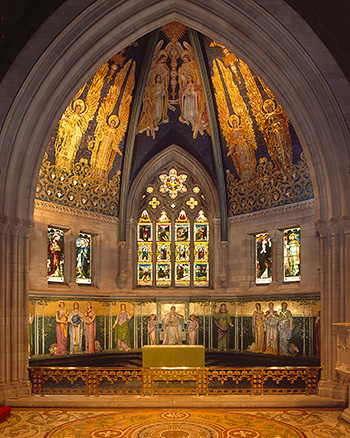
The graceful figures in the mosaic mural in the apse of Sage Chapel were designed in the late 1890s by artist Ella Condie Lamb. Photo: University Photography file photo.
Colorful family legacy began with Sage Chapel apse mosaics
They are at every concert in Sage Chapel and attend every lecture, religious service and choir rehearsal. They witness every wedding that takes place in the chapel -- and have since 1900.
They are the graceful figures in the mosaic mural in the apse of the chapel, designed in the late 1890s by artist Ella Condie Lamb, who the New York Herald called "the Mistress of Mosaic," and installed by J&R Lamb Studios, a New York City decorative arts company headed by renowned architect and urban planner Charles Rollinson Lamb, her husband (who also led the redecoration of Sage Chapel).
The mural, two years in the making, was unveiled at spring commencement in 1900.
"Grandmother's mosaics in the chapel are one of the best things she ever did," says Robin Tait '51. He chose Cornell, in part, because of his grandmother's legacy.
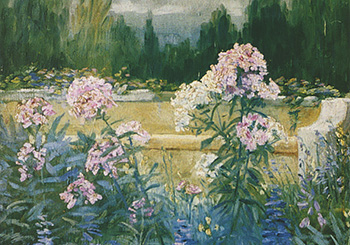
Detail of "In a Garden" (1905), an oil on canvas by Ella Condie Lamb of flowers in the terrace garden of the family's country home in Cresskill, New Jersey. Image: provided.
"The mosaics in Sage Chapel are the jewel of the interior and closely reflect the ideals of the university," says Nancy Green, the Gale and Ira Drukier Curator of European and American Art at the Herbert F. Johnson Museum of Art.
Green says Charles and Ella Lamb consulted with then-Cornell President Jacob Gould Schurman to design a mural representing "education" as an idea. One trio of classically draped female figures represents science -- biology, astronomy and physics -- while another trio represents the arts -- literature, architecture and music. Philosophy, the seated male figure in the center, ties the mural together, flanked by two young children.
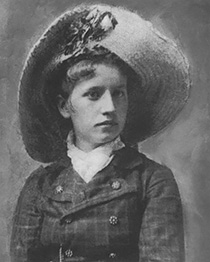
Photograph of Ella Condie at approximately age 16, ca. 1878. Image: provided.
The figures on the extreme left and right represent "young manhood" and "young womanhood," reflecting the university's commitment to coeducation, says Green.
"The Lambs' accomplishment was to create a space that enhances the visitor's experience," says Green. Whether used for a religious purpose or for a public ceremony, she says, the art provides the perfect foil.
"That family believed in a Renaissance education," says Tait. "They never stopped learning."
Working for her husband's firm, Ella Condie Lamb also designed mosaic and stained glass murals for the Lakewood Chapel in Lakewood Cemetery, Minneapolis, Minnesota; the Trask mosaic fireplace in Tuxedo Park, New York; and "The Open Book," a mural painted for the Flower Memorial Library in Watertown, New York.
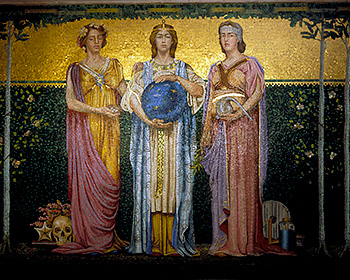
Detail of three of the figures in the mosaic mural in the apse of Sage Chapel. Photo: University Photography file photo.
Tait grew up knowing that "Amma," as her family called Ella Condie Lamb, was a well-known artist, but he didn't lay eyes on her Sage Chapel mural until 1947, when he visited Cornell as a prospective student. Seeing it was one of the highlights of a three-day visit -- along with watching an upperclassman stand on a table in Willard Straight Hall to recite Rudyard Kipling's poem "Gunga Din."
At Cornell, Tait was a passionate student of history and developed lasting relationships with his professors, in particular philosophy scholar Gregory Vlastos and political theory scholar Mario Einaudi.
The Lambs instilled a love of education in their children and grandchildren. They also passed on a dedication to philanthropy.
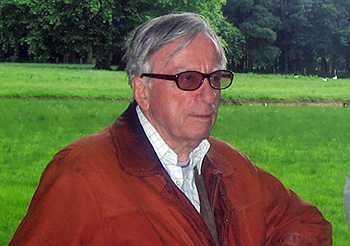
Robin Tait '51. Photo: provided.
Tait, an attorney who has practiced in Paris for years, extended his family's legacy at Cornell this fall by planning to establish the Tait Brothers Dean's Discretionary Fund, a $3 million discretionary endowment at Cornell Law School, together with his brothers Colin C. Tait '54 and Kevin S. Tait. He also has established a charitable trust that will provide three endowed scholarship funds. Two of the scholarships are in memory of his grandparents. The third honors his brother-in-law Stephen Collins '49.
"I didn't want them to be forgotten," he says of the family members for whom he named the scholarships. For the Law School, he envisions a discretionary fund at the disposal of the dean that can be used for forums and lecture series that will make the discussion of law "dynamic."
Between the Sage Chapel murals, the named scholarships and the endowment fund at the Law School, the family of Robin Tait will not be forgotten at Cornell.
"I don't think anyone can enter Sage [Chapel] without being moved by its beauty," says Green.